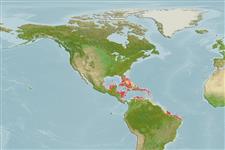Common names from other countries
>
Blenniiformes (Blennies) >
Labrisomidae (Labrisomids)
Etymology: Paraclinus: Greek, para = the side of + Greek, klinein, kline = sloping and bed, due to the four apophyses of sphenoid bone (Ref. 45335).
More on author: Steindachner.
Environment: milieu / climate zone / depth range / distribution range
पारिस्थितिकी
समुद्री प्रवाल-भित्ति संयुक्त; गहराई सीमा 0 - 6 m (Ref. 9710). Tropical
Western Central Atlantic: southern Florida, USA and the Bahamas to Central America and northern South America; absent in the Antilles, except for Cuba.
आकार / वज़न / Age
Maturity: Lm ? range ? - ? cm
Max length : 10.0 cm TL पुल्लिंग / अलिंग; (Ref. 7251)
Short description
आकृति विज्ञान | मौरफोमैटरिक्स
पृष्ठीय रीढ़ (सम्पूर्ण): 28 - 29; पृष्ठीय सौफट रेज़ (सम्पूर्ण): 1; गुदा कांटा 2; ऐनल सौफट रेज़: 19 - 20
Inhabits seagrass beds and coral reefs. May be found associated with the sponge Verongia fistularis (Ref. 13628). Sexual dimorphism in the shape of the head and dorsal fin (Ref. 5521). Oviparous (Ref. 205). Polygynous males guard the eggs which are spawned by several females in nests (Ref. 55842).
Life cycle and mating behavior
परिपक्व अवधि | पुनरुत्पत्ति | मछलीऔ का अंडे देना | अंडे | Fecundity | लार्वा
Females deposit eggs in nests often associated with the sponge Verongia fistularis (Ref. 55842). Males fan the eggs for aeration which are probably spawned by several females owing to different developmental stages of eggs present in the nests (Ref. 205). Pairs will spawn routinely in aquaria in the absence of the sponges (Ref. 205).
According to aquarium observations by Breder (1941), "spawning takes place with the female in an inverted position while the male remains upright, wandering females adding to the eggs. The nesting male on sexual exhaustion repulses additional females with a typical warning attitude and eventual biting similar to its reaction to another male or other fish."
Robins, C.R. and G.C. Ray, 1986. A field guide to Atlantic coast fishes of North America. Houghton Mifflin Company, Boston, U.S.A. 354 p. (Ref. 7251)
IUCN Red List Status (Ref. 130435)
CITES (Ref. 128078)
Not Evaluated
Threat to humans
Harmless
Human uses
जलजीवालय: व्यापारिक
अधिक जानकारी
संदर्भजलीयकृषिजलीयकृषि रूपरेखाखींचआनुवंशिकीElectrophoresesहैरेटिबिलटीबीमारीप्रक्रमणMass conversion
सहयोगीयोतस्वीरेStamps, Coins Misc.ध्वनिसिगुयटिरारफ्तारतैरने के प्रकारगिल क्षेत्रOtolithsदिमागदृष्टि
साधन
Special reports
Download XML
इंटरनेट स्रोत
Estimates based on models
Preferred temperature (Ref.
115969): 23.8 - 28.2, mean 27.3 (based on 640 cells).
Phylogenetic diversity index (Ref.
82804): PD
50 = 0.5000 [Uniqueness, from 0.5 = low to 2.0 = high].
Bayesian length-weight: a=0.00912 (0.00399 - 0.02083), b=3.06 (2.87 - 3.25), in cm Total Length, based on LWR estimates for this (Sub)family-body shape (Ref.
93245).
Trophic level (Ref.
69278): 3.7 ±0.4 se; based on size and trophs of closest relatives
Fishing Vulnerability (Ref.
59153): Low vulnerability (10 of 100).
